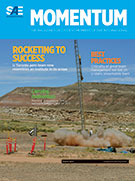Magazine

Aerospace & Defense Technology: September 2022
2022-09-01
The Sky is No Longer the Limit Celebrating 75 Years of Air Force Technology Air Force Technology Timeline Leveraging New Technologies for Mil/Aero Electronic Systems MOSA Enclosure Design for Military Systems Three Challenges to 5G's Military Success How to Specify and Select RF Filters Investigation of Requirements and Capabilities of Next-Generation Mine Warfare Unmanned Underwater Vehicles Model-based systems engineering (MBSE) tools, including functional flow block diagrams and functional hierarchies, are used to logically define mine countermeasure (MCM) UUV operations and support the development of alternative concepts of operations. On the Pulsed Laser Ablation of Metals and Semiconductors A comparison of effects across disparate experimental regimes through the study of pulsed laser ablation over several orders of magnitude in pulse duration, fluence, and material properties.












